Are Pugs Hypoallergenic? The Truth About Pugs and Allergies

If you’re considering getting a furry companion, it’s important to take into account any allergies you or your loved ones may have. While some people may think that small dogs like Pugs are hypoallergenic, this is actually a common misconception. Despite their cute and lovable appearance, Pugs are not a hypoallergenic breed of dog.
Read on for an in-depth answer about Pugs and their allergy risks.
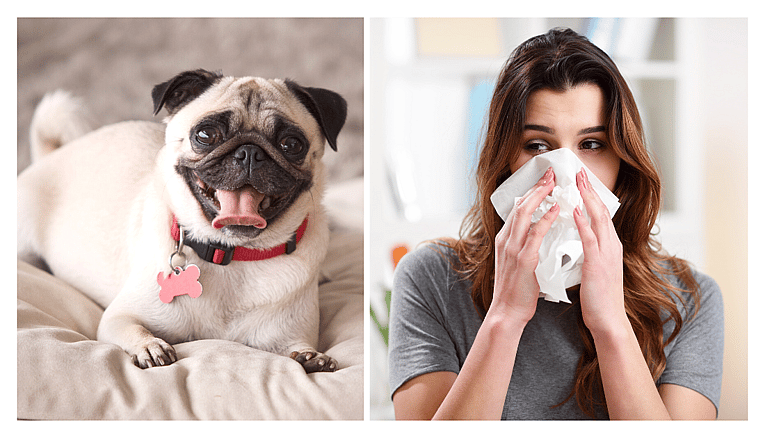
What does hypoallergenic mean?
When people have allergic reactions to animals, the response is due to the presence of specific proteins present on the animal’s skin, in the fur, urine, or saliva. Along with other allergens like pollen and dust, allergens are shed into the environment after attaching to fur or dead skin cells.
“Hypoallergenic” refers to matter that produces fewer allergy-inducing substances than what’s considered typical. A hypoallergenic dog’s skin, hair, saliva, and urine release fewer allergens into the environment, which leads to fewer reactions in people with pet allergies.
Can a dog really be hypoallergenic?
Some dog breeds can be considered hypoallergenic because they don’t produce as many allergens as other dog breeds. No dog breed is allergy-proof, but for people who suffer from dog allergies, certain dogs will trigger fewer immune reactions due to the fact that the amount of dander they shed is quite low.
“From a scientific standpoint, there is no such thing as a completely hypoallergenic dog, but some breeds are less likely to cause problems for people with allergies than others. Breeds with a single coat, rather than a double coat, tend to produce less dander and shed less hair, and may therefore be better options for people with allergies. Some examples of hypoallergenic breeds include Poodles, Bichon Frises, and Maltese.”
Dr. Jennifer Coates, veterinarian and author
What triggers pet allergies in humans?

As mentioned, pet allergy symptoms are triggered by proteins in the skin, saliva, and urine of animals. These proteins are shed into the environment along with dog hair and dog dander. These allergens can cause allergy sufferers to experience runny noses, watery eyes, sneezing, and respiratory problems.
Fortunately, because pet allergies don’t mean an individual is allergic to the dog itself, there are adjustments that can be made for dog lovers with allergies.
Most Hypoallergenic Dog Breeds
Dog breeds that produce the least amount of dander include the following, as these breeds tend to shed less than others.
- Schnauzer
- Irish Water Spaniel
- Soft-Coated Wheaten Terrier
- Peruvian Inca Orchid
- Maltese
- Spanish Water Dog
- American Hairless Terrier
- Poodle
Least Hypoallergenic Dog Breeds
Dogs may be more of an allergy risk if they shed significantly, tend to have dry skin issues, and/or salivate often. These breeds are considered some of the least hypoallergenic options for dog owners.
- Basset Hound
- German Shephard
- Saint Bernard
- Labrador Retriever
- Cocker Spaniel
- Siberian Husky
- Pug
Are Pugs hypoallergenic dogs?

Pugs have a double coat of fur that sheds frequently, which can release dander and other allergens into the air. In addition, they are known to drool, which can be another source of allergens for some people. This can make them a poor choice for individuals who suffer from allergies or asthma. However, there are certain breeds of dogs that are more hypoallergenic than others, so it’s important to do your research before bringing a pet into your home.


That said, Pugs are, by far, not the least hypoallergenic dog breed to choose from, so people who want to live with a Pug despite having a sensitive immune system don’t necessarily have to forego pet ownership.
Tips for Dog Owners with Allergies
If you have allergies or asthma, try the following tips to manage your pet’s dander and avoid allergy triggers.
- Diet: Feeding your dog a high-quality diet that focuses on skin and coat health can help reduce allergic reactions by preventing dry skin and excessive shedding. On top of lessening your allergic reactions, a proper diet will also improve your pet’s health. (see specific recommendations below)

- Grooming: Regular grooming can be incredibly helpful in keeping allergens at bay. Your dog needs to be bathed and brushed regularly. Be sure to keep your Pug’s face clean and trim his or her nails regularly.
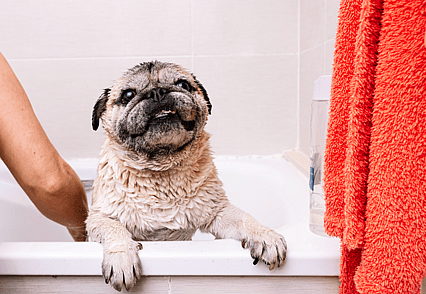
- Home Environment: Keep your home as clean as possible to prevent allergens from settling on your furniture. Vacuum carpets often, and wash throw blankets, rugs, and your dog’s bedding once a week if your allergies are severe. Use air purifiers to keep dander from circulating through your home.

- Barriers: Pugs are usually tolerant about wearing dog clothes, so consider having your pet wear hypoallergenic puppy pajamas to minimize shedding. You might also want to use allergy treatments on your dog’s fur after grooming sessions.

What’s the best food for my pug?
The three foods that are super healthy and that almost every dog loves, even the pickiest dogs, are:
1. The Farmer’s Dog.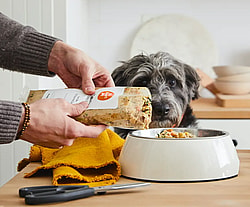
This is a fresh-frozen food that’s delivered to your home in just the right amounts for your dog. There are a number of fresh frozen dog foods available on the market and I tested them all. The Farmer’s Dog came up the winner with my picky dogs. You can see the fresh frozen food test here.
Save 60% on your first order
—
2. Sundays Food For Dogs
This is an air-dried food. It has the convenience of kibble (just pour it in the bow) but is much much healthier. It’s like little pieces of jerky, so dogs go crazy for it. There are a number of air-dried foods on the market. My dogs tested 3 of them. You can see the results of the air-dried food test here.
Get 35% off your first order + free shipping w/ code ROCKY35
3. We Feed Raw.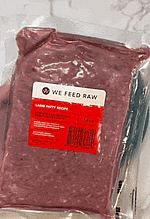
This raw food for dogs comes delivered to your home is perfectly sized portions for your pup. They primarily source their ingredients from trusted U.S. farmers, with two exceptions: venison and lamb. These ingredients are sourced from New Zealand, where some of the highest-quality and most ethically raised venison and lamb can be found. Pasture-raised and grass-fed and finished, we highly recommend trying these formulas if you’re interested in the best-quality ingredients. Save 25% on your first order.
Supplements: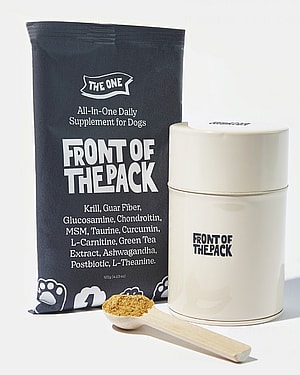
I highly recommend using a supplement on your dog’s food, not matter what you feed them, to ensure the meal is balanced and they are getting all the right supplements to help them stay healthy. The supplement I use is called The One from Front of the Pack. It has 12 ingredients that have been clinically-proven to keep your dog’s joints, skin, heart, digestion, and even their breath in tip-top shape. It’s also a powder, so easy to sprinkle on your dog’s food. For a limited time, when you buy one month you get a second month free.
FAQ
Are Pug hypoallergenic?
Pugs are not considered hypoallergenic.
Do Pugs shed a lot?
Pugs don’t shed a lot, though they may shed more than usual when losing their winter coat.
Can people with allergies keep Pugs as pets?
Some people with allergies can keep Pugs as pets if they practice proper dog grooming and pet care to reduce dander.
What are the symptoms of pet allergies?
Pet allergies can cause itchy or watery eyes, runny noses, sneezing, and respiratory issues.
How can I reduce my exposure to pet allergens?
Keeping both your home and your pet as clean as possible and using an air purifier can reduce your exposure to allergens.
Can regular grooming help reduce pet allergens?
Yes, regular grooming can help reduce pet allergens by reducing dander.
What are some common allergens found in pet dander?
Pollen, dust, dust mites, and mold.
Are there any medications or treatments that can help alleviate pet allergies?
Yes, antihistamines and allergy shots may help reduce allergies. Additionally, using Allerpet on your pet’s skin/fur can reduce dander shedding.
Do hypoallergenic dog breeds exist?
According to the American Kennel Club, some dog breeds produce fewer allergens than others, so they’re technically hypoallergenic dog breeds.
Can Pugs cause asthma attacks?
Pugs may cause asthma attacks in individuals with severe asthma.
How do I know if I’m allergic to Pugs?
Exposure to these animals triggers immune responses, which will be noticeable if you experience a runny nose, itching, watery eyes, or respiratory issues.
Can children with allergies keep Pugs as pets?
Possibly, if the child’s condition isn’t severe and the animal is groomed regularly.
How can I prepare my home for a Pug if I have allergies?
Clean your home often and designate a pet-free room that you can recover in after an allergic reaction.
What are some non-allergenic pets?
Fish and reptiles typically don’t induce allergies. Small rodents and birds may also be hypoallergenic.
Can allergy shots help with pet allergies?
Yes, allergy shots may help reduce pet allergies.
What are some common allergens found in dog saliva?
The same allergens in a dog’s dander are also present in dog saliva.
How often do I need to groom my Pug?
At least every 4-6 weeks, but you may groom more often to prevent allergies.
If you have pet allergies, you don’t necessarily have to give up your furry friend to keep your reactions at bay. Take the right precautions and gauge the way your immune system reacts to your dog. Chances are, a few accommodations will help reduce your allergies and keep you and your pet happy together for years to come.
